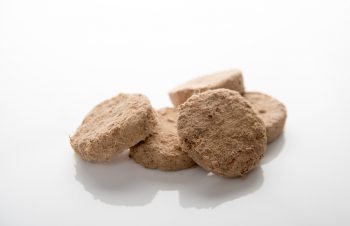Freeze-dried dog food has an exceptionally long shelf life primarily due to the removal of 98-99% of the moisture content during the freeze-drying process1. This reduction in moisture significantly hinders the growth of mold, yeast, and bacteria, which are common causes of food spoilage. When stored properly, freeze-dried dog food can have a shelf life of up to 25 years or more12. The process also ensures that the food retains about 97% of its original nutritional value, which is a higher retention rate compared to other food preservation methods3.
Storage Conditions
The longevity of freeze-dried dog food is highly dependent on storage conditions. To achieve the maximum shelf life, the food must be stored in airtight containers, such as Mylar bags with oxygen absorbers, and kept in a cool, dry place that remains under 75 degrees Fahrenheit45. Exposure to moisture, high temperatures, and oxygen can significantly reduce the food’s shelf life and lead to spoilage67. In the case of Mylar bags, the food can last up to 25 years, while in Ziploc bags, the food’s life expectancy is still quite extensive89.
Signs of Spoilage
Despite the long shelf life of freeze-dried dog food, it is not impervious to spoilage. Signs that the food has gone bad include visible mold, unexpected changes in color, bad odors, and changes in texture, such as food becoming chewy rather than crisp10. Consuming spoiled freeze-dried dog food can cause gastrointestinal upset in dogs, such as vomiting or diarrhea, and in some cases, can lead to serious illness if it contains harmful bacteria like E. coli11.
Additional Considerations
While freeze-drying is a slow process taking over 24 hours, it ensures that there’s no risk of botulism, and it can also destroy certain kinds of parasites that are vulnerable to the freezing temperatures used in the process1213. However, not all foods are suitable for freeze-drying, and the texture of the final product might not be appealing to all pets or pet owners12.
To conclude, the shelf life of freeze-dried dog food is extensive when proper storage methods are followed, making it a convenient and long-lasting option for pet food storage. However, it is crucial to remain vigilant for any signs of spoilage and to understand the storage requirements to ensure the food remains safe and nutritious for consumption. The maintenance of nutritional value and the safety against common foodborne pathogens make freeze-dried dog food a reliable choice for pet owners looking for longevity in their pet’s food supply.
Frequently Asked Questions About Freeze Dried Dog Food
1. What is freeze-dried dog food?
Freeze-dried dog food is made by removing almost all moisture from the food through a process called lyophilization, which involves freezing the food and then subjecting it to a vacuum that removes the ice by sublimation. This process preserves the food’s nutrients, flavor, and texture, resulting in a lightweight and non-perishable product that is convenient for storage and feeding.
2. How long can freeze-dried dog food last?
Properly stored freeze-dried dog food can last up to 25 years, as the lack of moisture prevents the growth of microorganisms that cause spoilage. To achieve this extended shelf life, the food must be kept in airtight containers away from heat and moisture.
3. Does freeze-dried dog food retain its nutritional value?
Freeze-dried dog food retains up to 97% of its original nutritional value, making it one of the best methods for preserving food without significant loss of vitamins and minerals. This is because the freeze-drying process is gentle and does not involve high temperatures that can destroy sensitive nutrients.
4. Can freeze-dried dog food go bad?
Yes, freeze-dried dog food can spoil if exposed to moisture, heat, or air. Signs of spoilage include mold, bad odors, and changes in texture. It’s important to store the food in airtight containers and consume it before its expiration date to prevent spoilage.
5. Is freeze-dried dog food safe from bacteria and parasites?
Freeze-dried dog food is generally safe from bacteria and parasites because the freeze-drying process involves extreme temperatures that are inhospitable to such organisms. However, it is still essential to handle and store the food properly to minimize the risk of contamination.
6. How do you store freeze-dried dog food for long-term use?
For long-term storage, freeze-dried dog food should be kept in airtight containers such as Mylar bags with oxygen absorbers and stored in a cool, dry place that stays under 75 degrees Fahrenheit. Proper storage is crucial to prevent reabsorption of moisture and to maintain the food’s shelf life.
7. Can freeze-dried dog food be rehydrated?
Yes, freeze-dried dog food can be rehydrated by adding water, which restores the food’s texture and may make it more palatable for some dogs. Rehydration is a simple process; just add the recommended amount of water and wait a few minutes before serving.
8. What are the advantages of feeding my dog freeze-dried food?
The advantages of feeding freeze-dried dog food include a longer shelf life, retention of nutritional value, convenience of storage and transportation, and typically higher palatability for pets due to the concentration of flavors and nutrients. It’s also often seen as a good compromise between raw diets and traditional kibble.
9. How does freeze-dried dog food compare to kibble?
Freeze-dried dog food is typically more nutrient-dense than kibble, as it undergoes less processing and does not require high temperatures, which can degrade certain nutrients. It is also generally more palatable and closer to raw food, providing a fresher taste experience for the dog.
10. Can all types of dog food be freeze-dried?
Not all dog foods are suitable for freeze-drying; high-fat foods or those with high moisture content may not freeze-dry well. Additionally, some textures and nutritional contents may be altered through the freeze-drying process, so it is best suited for certain types of dog food formulations.
The post How Long Does Freeze Dried Food Last? appeared first on iHeartDogs.com.

